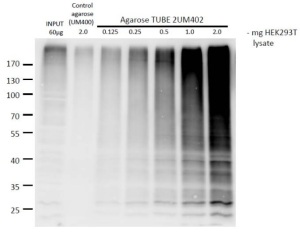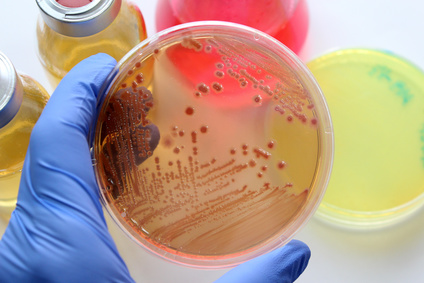Traditional methods to detect and purify poly-ubiquitinated proteins require either anti ubiquitin antibodies or Ubiquitin Binding Associated domains (UBAs) which display rather low affinity for Ubiquitin and show only little (if any) specificity for specific ubiquitin linkages (e.g. K63 or K48). Furthermore, these strategies require the inclusion of inhibitors of both Deubiquinating enzymes (DUBs) and Proteasome activity to protect the integrity of poly-ubiquitylated proteins, which might alter cell physiology, which in turn may negatively impact the result or introduce experimental artifacts.
To overcome these problems, LifeSensors have developed Tandem Ubiquitin Binding Entities (TUBEs).
 TUBEs are essentially tandem UBAs with dissociation constants for tetra-ubiquitin in the nanomolar range. TUBEs have also been demonstrated to protect proteins from both deubiquitination and proteasome-mediated degradation, even in the absence of inhibitors normally required to block such activity. The nanomolar affinity of TUBEs for poly-ubiquitinated proteins allows the efficient isolation and identification of ubiquitinated proteins from cells, tissues and organs.
TUBEs are essentially tandem UBAs with dissociation constants for tetra-ubiquitin in the nanomolar range. TUBEs have also been demonstrated to protect proteins from both deubiquitination and proteasome-mediated degradation, even in the absence of inhibitors normally required to block such activity. The nanomolar affinity of TUBEs for poly-ubiquitinated proteins allows the efficient isolation and identification of ubiquitinated proteins from cells, tissues and organs.
If you’re interested either in detecting poly-ubiquitinated proteins or enriching/purifying them, TUBEs should be of great help to you – especially if you are specifically interested in K63 linkages.
Why can TUBEs help you?
- They show increased affinity – Up to a 1,000-fold increase in affinity for poly-ubiquitin moieties over the single ubiquitin binding associated domain.
- They can be used under more physiological conditions – Poly-ubiquitin chain protection without inhibitors of proteasomal or deubiquitinating activity.
- They are ideal substitutes for Ubiquitin specific antibodies for enrichment of poly-ubiquitinated proteins.
What kind of TUBEs are available and how to apply them?
- Affinity tagged TUBEs (linked to either GST-, HIS-, or FLAG-tags): For the identification and characterization of polyubiquitinated proteins
- Agarose-coupled TUBEs: For “one-step” pull downs of polyubiquitinated proteins
- Biotin-coupled TUBEs: For the detection of polyubiquitinated proteins by ligand blotting (“far western blotting”)

EEnrichment for polyubiquitin with Agarose-TUBE2. HEK293T cells were lysed in TBS containing 5mM EDTA, 1% NP 40, Protease Cocktail Inhibitors, 50 µM PR619, and 5mM 1, 1o-phenanthroline. Total protein content of pre-cleared lysate was determined by Bradford, and 10 µl of Agarose-TUBE 2 resin was added to indicted amounts (mg except where indicated). Reactions were rotated for 3.5h (4°C), washed three times with TBS plus EDTA, and analyzed by SDS-PAGE and immunoblotting for ubiquitin using the VU-1 Ubiquitin Monoclonal Antibody (1:1000). - HRP-coupled TUBEs: For in situ labeling during detection of poly-ubiquitin by histochemistry and for the detection of poly-ubiquitinated proteins by ligand blotting
- Fluorescent TUBEs: For cytochemical stainings of poly-ubiquitinated proteins with fluorescence microscopy
- K63-speficic TUBEs: For highly sensitive detection of K63 poly-ubiquitinated chains (100 to 1000-fold weaker affinity for chains linked through K48 or K11)
Useful to know: three TUBE versions are available for some of the TUBE types. Whereas TUBE 1 exhibits higher affinity toK63 tetra-ubiquitin relative to K48 linked species, TUBE 2 shows equivalent affinities for both K63 and K48 tetra-ubiquitin (usually this TUBE is a reasonable starting point if the nature of the ubiquitin linkage is unknown), and finally, TUBE 3 exhibits equivalent affinities for both K63 and K48 tetra-ubiquitin, but the relative affinity for mono-ubiquitin is lower than that of either TUBE 1 or TUBE 2.
Related products:
- PR-619 Ub & Ubl inhibitor (182SI9619-5mg)
- 1, 10 – Phenanthroline (Metallopeptidase inhibitor )
- Control Agarose
- Agarose-TUBE 2 resin (182UM402-1ML)
- VU-1 Ubiquitin Monoclonal Antibody
Are you doing ubiquitin-detection experiments?
Have you come up against sensitivity or selectivity problems?
Feel free to get in touch through the form below, I’d be happy to share advice for setting up your experiments with TUBEs.




2 Responses
Hi,
I am using UM402 to check the ubiquination status of my protein of interest in HCT116 cell line. I have two questions to ask.
1. Do I need to incubate my cells with IL-1β to induce ubiquitination?
2. Do I need to keep a IgG negtive control when I run this experiment?
Dear Arun,
Thank you for your comment on our blog.
I see you are based in South Korea.
Please refer to my email where I direct you to our partner LifeSensors.
They have put you in contact already with their local distributor in your country.
Best of luck with your project.
Kind regards,
Isabelle